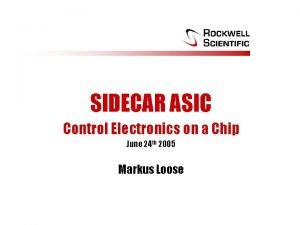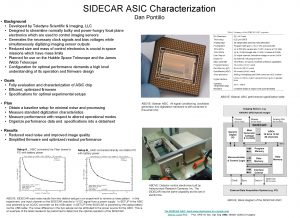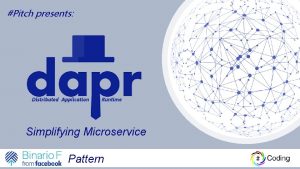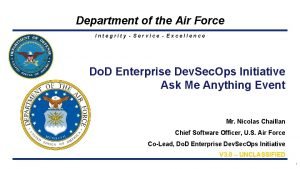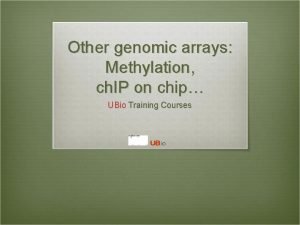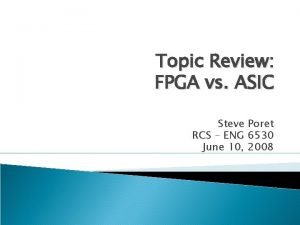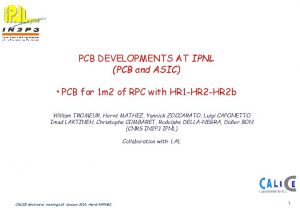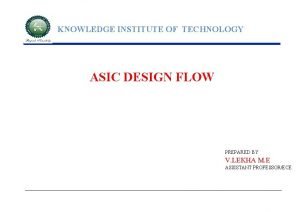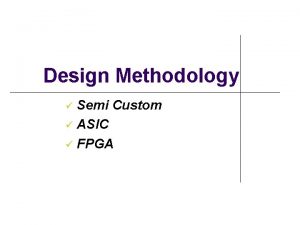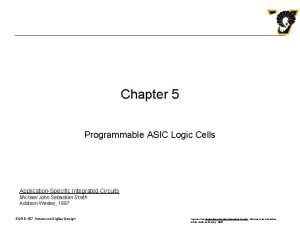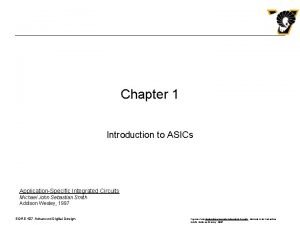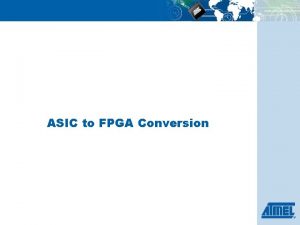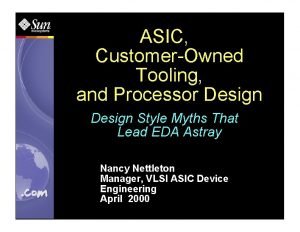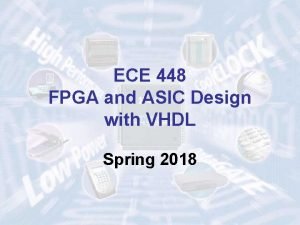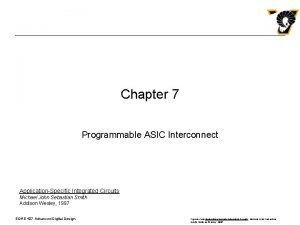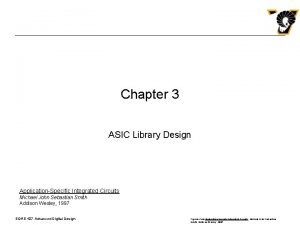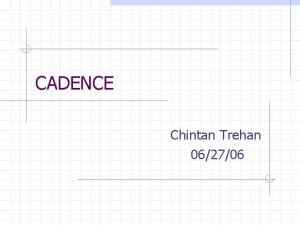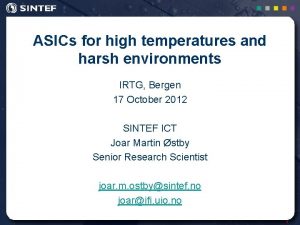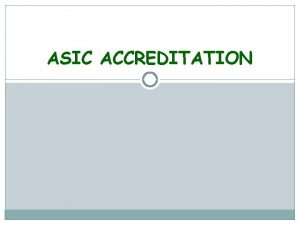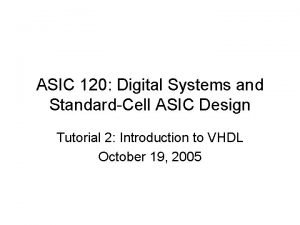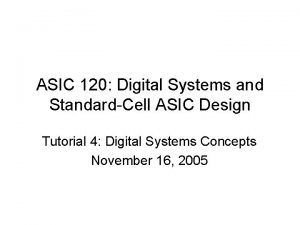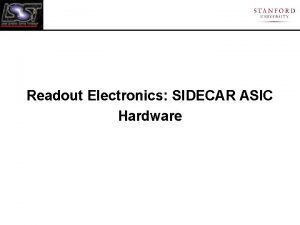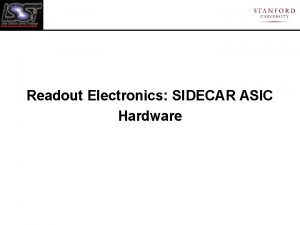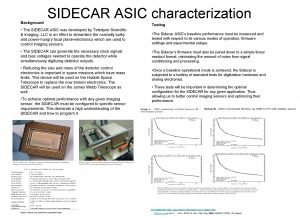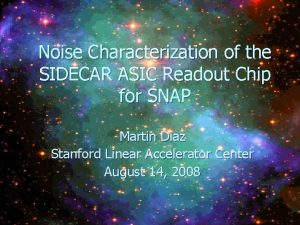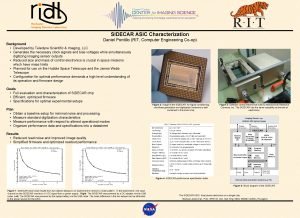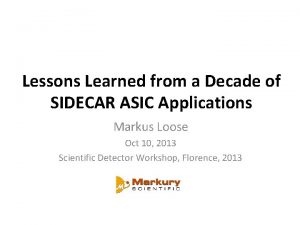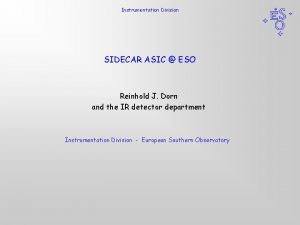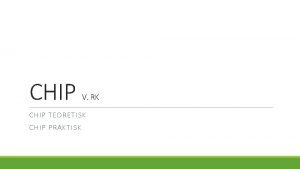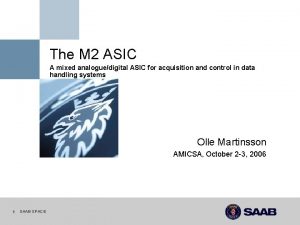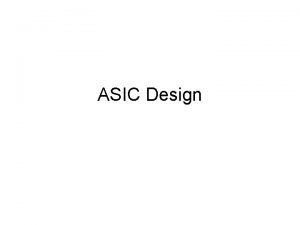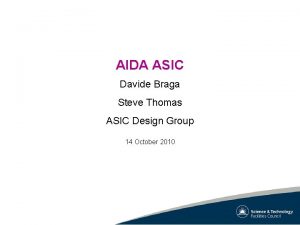SIDECAR ASIC Control Electronics on a Chip June





















- Slides: 21

SIDECAR ASIC Control Electronics on a Chip June 24 th 2005 Markus Loose

The SIDECAR ASIC Control Electronics on a Chip Replace this with this! 1% volume 1% power 1% hassle ML, Detector Workshop, June 2005 Chart 2

SIDECAR Architecture main clock External Electroni cs synchro n. Digital Control Microcontroller for Clock Generation and Signal Processing Digital Generic I/O Bias Generator clocks bias voltage s data in data out Digital I/O Interfac e Data Memor y Data Memory ML, Detector Workshop, June 2005 Chart 3 Progra m Memor y Amplificati on and A/D Conversio n analog mux out Multiplexer, e. g. HAWAII-2 RG SIDECAR: System for Image Digitization, Enhancement, Control and Retrieval SIDECAR

SIDECAR Feature List • 36 analog input channels, each channel provides: – – – • 500 k. Hz A/D conversion with 16 bit resolution 10 MHz A/D conversion with 12 bit resolution gain = 0 d. B …. 27 d. B in steps of 3 d. B optional low-pass filter with programmable cutoff optional internal current source (as source follower load) 20 analog output channels, each channel provides: – programmable output voltage and driver strength – programmable current source or current sink – internal reference generation (bandgap or vdd) • • 32 digital I/O channels to generate clock patterns, each channel provides: – – input / output / highohmic selectable output driver strength and polarity pattern generator (16 bit pattern) independent of microcontroller programmable delay (1 ns - 250µs) 16 bit low-power microprocessor core (single event upset proof) – responsible for timing generation and data processing – 16 kwords program memory (32 k. Byte) and 8 kwords data memory (16 k. Byte) – 36 kwords ADC data memory, 24 bit per word (108 k. Byte) – additional array processor for adding, shifting and multiplying on all 36 data channels in parallel (e. g. on-chip CDS, leaky memory or other data ML, Detector Workshop, June 2005 Chart 4 processing tasks)

Microcontroller Block Diagram ML, Detector Workshop, June 2005 Chart 5

Sample Micro Code • Subsection of the assembler code for reading a complete frame of the H 2 RG • pixelloop: Shows the innermost loop that reads one row of pixels BCLR R 6, 10 R 7, 10 // ADC 7 SUB R 3, h 60 ST (R 3), R 5 IN R 0, Strobe OUT STROBEREG, R 0 IN R 0, Test. High MOVLH RX 0, R 0 IN R 0, Test. Low MOVW RX 0, R 0 SHR RX 0, 2 MOVW R 0, RX 0 ST (R 6), R 0 ST (R 3), R 4 // set data storage address // to lower memory block // enable ADC test bus driver // set ADC conversion trigger // read upper 2 ADC bits // read lower 16 ADC bits // reduce ADC data to 16 bits // store ADC data in memory // disable ADC test bus driver // ADC 15 ADD R 3, h 20 ST (R 3), R 5 // IN R 0, ADCDefault OUT STROBEREG, R 0 // IN R 0, Test. High // MOVLH RX 0, R 0 IN R 0, Test. Low // MOVW RX 0, R 0 SHR RX 0, 2 // OUT Lower. Clks, R 1 // MOVW R 0, RX 0 ST (R 7), R 0 // ST (R 3), R 4 // ML, Detector Workshop, June 2005 Chart 6 enable ADC test bus driver reset ADC trigger read upper 2 ADC bits read lower 16 ADC bits reduce ADC data to 16 bits HCLK => 0 store ADC data in memory disable ADC test bus driver BSET R 6, 10 R 7, 10 // ADC 23 ADD R 3, h 20 ST (R 3), R 5 IN R 0, Test. High MOVLH RX 0, R 0 IN R 0, Test. Low MOVW RX 0, R 0 SHR RX 0, 2 MOVW R 0, RX 0 ST (R 6), R 0 ST (R 3), R 4 // ADC 31 ADD R 3, h 20 ST (R 3), R 5 IN R 0, Test. High MOVLH RX 0, R 0 IN R 0, Test. Low MOVW RX 0, R 0 SHR RX 0, 2 MOVW R 0, RX 0 ST (R 7), R 0 ST (R 3), R 4 OUT Lower. Clks, R 2 INC DEC JPNZ DEC // set data storage address // to upper memory block // enable ADC test bus driver // read upper 2 ADC bits // read lower 16 ADC bits // reduce ADC data to 16 bits // store ADC data in memory // disable ADC test bus driver // HCLK => 1 R 6 // increment address for ADC 7/23 RX 3 // decrement pixel counter pixelloop, DLY, LKY // jump if RX 3 not zero R 7 // decrement address for ADC 15/31

ASIC Floorplan ML, Detector Workshop, June 2005 Chart 7

SIDECAR Micrograph 14. 5 mm 22 mm ML, Detector Workshop, June 2005 Chart 8

Callouts of Various Layout Sections Inside the ASIC Pre. Am p 16 -bit ADC Instr. Memory Micro. Controller Logo ML, Detector Workshop, June 2005 Chart 9

Test Results – Warm and Cryogenic • The SIDECAR ASIC has been tested at room temperature and cryogenically. • Cryogenic tests have been carried out at 37 K (JWST) • The correct operation of all blocks has been verified: – – – – Microcontroller Memories (except dual port memory due to leakage problem) Digital I/O block (clock generation) Bias generation Data interface to external electronics 12 -bit ADC 16 -bit ADC Pre. Amp • All blocks operate consistently and show the same or improved performance at cryogenic temperatures compared to room temperature. ML, Detector Workshop, June 2005 Chart 10

12 -bit ADC Results Measured at 7. 5 MHz Sample Rate DNL INL [ LSB ] DNL [ LSB ] INL Output Code • Differential Non-Linearity: < ± 0. 3 LSB • Integral Non-Linearity: < ± 0. 7 LSB • Temporal Noise at 300 K < 0. 4 LSB ML, Detector Workshop, June 2005 Chart 11 Output Code

16 -bit ADC Results Measured at 125 k. Hz Sample Rate DNL INL [ LSB ] DNL [ LSB ] INL Output Code • Differential Non-Linearity: < ± 0. 3 LSB • Integral Non-Linearity: < ± 0. 2 LSB • Temporal Noise at 300 K < 5 LSB • Temporal Noise at 77 K < 3 LSB ML, Detector Workshop, June 2005 Chart 12 Output Code

SIDECAR Driving HAWAII-2 RG Inside the dewar at T = 37 K PC SIDECAR ASIC IDL Software for SIDECAR Control and Data Capture Vreset 000 w Dsub 384 w Clock 0 cd w HAWAII-2 RG Sensor Chip Assembly Analog Video Biases Power Supply Data In PCI Card with FPGA & Memory Serial Interface Data Out Clocks Master Clock 3. 3 V Digital Supply Only 7 lines needed to operate the SIDECAR ASIC in base configuration (3 signal & 4 power lines) ML, Detector Workshop, June 2005 Chart 13 3. 3 V Analog Supply The microcontroller driven SIDECAR ASIC generates all biases & clocks and digitizes the analog video outputs The SIDECAR ASIC provides all 27 signals required to operate the HAWAII-2 RG

Noise Results – Differential Operation • HAWAII-2 RG with 2. 5 µm cutoff Hg. Cd. Te • CDS of two consecutive frames • CDS noise: 16 e • Better than conventional controller ML, Detector Workshop, June 2005 Chart 14

Total CDS Noise in 1000 s Method 1: Difference of two CDS frames divided by. The CDS noise is given by the width of the distribution. noise = 16. 3 e- Method 2: Take many CDS frames and look at each pixel’s variation from frame to frame. The CDS noise is given by the mean of the distribution. noise = 15. 6 e. ML, Detector Workshop, June 2005 Chart 15

Total Fowler 8 -8 Noise in 1000 s Method 1: Difference of two Fowler 8 -8 ramps divided by. The noise is given by the width of the distribution. noise = 6. 7 e. Method 2: Meets NIRCam noise of 9 e- Take many Fowler 88 ramps and look at each pixel’s variation from ramp to ramp. The noise is given by the mean of the distribution. noise = 6. 8 e. ML, Detector Workshop, June 2005 Chart 16

Total Up-The-Ramp Noise (1000 s) Method 1: Difference of two ramps (22 x 4 frames each) divided by. The noise is given by the width of the distribution. noise = 4. 95 e- Meets NIRSpec noise of 6 e. Method 2: Take many ramps and look at the slope variation from ramp to ramp for each pixel. The noise is given by the mean of the distribution. noise = 5. 2 e. ML, Detector Workshop, June 2005 Chart 17

Noise Reduces With Fowler n-n • Two ramps, 146 frames each, have been analyzed with respect to noise reduction by Fowler sampling for a 1000 s integration time. • With Fowler 64 -64, the read noise is reduced to 3. 6 e- Actual noise reduction when using measured SIDECAR data ML, Detector Workshop, June 2005 Chart 18 Theoretical noise reduction assuming same initial CDS noise

ASIC Exceeds JWST Noise Requirements • The ASIC has demonstrated excellent noise performance that exceeds the requirements for all three near-infrared instruments ASIC by itself (NIRSpec 4 -22 multiaccum) Noise at low bias Noise at medium bias Noise, 200 k. Hz sampling JWST Requiremen t 2. 0 e- 1. 8 e- 1. 4 e- 2. 4 e (NIRSpec) ASIC + HAWAII-2 RG CDS 16. 5 e- 16. 2 e- 12. 5 e- ASIC + HAWAII-2 RG Fowler 8 -8 6. 8 e- 6. 7 e- 5. 1 e- 24 e(extrapolate d) 9 e(NIRCAM) • Direct shows ASICcomparison + HAWAII-2 RGwith discrete electronics (Leach controller) 6 e 5. 3 e 5. 2 e-* 4 e(4 – 22 multiaccum) (NIRSpec) superior ASIC performance: Leach SIDECAR ML, Detector Workshop, June 2005 Chart 19 CDS (Fowler 11) 16. 9 e(72 µV) 15. 4 e(65. 6 µV) Fowler 8 -8 6. 98 e(29. 7 µV) 6. 4 e(27. 3 µV) * Multiaccum calculated using only 4 out of 6 measured ramps to reduce frame-to-frame pedestal.

ASIC Flight Package for JWST Exploded View Detector + ASIC Sub. System Focal Plane Array SIDECAR ASIC ML, Detector Workshop, June 2005 Chart 20

Conclusion • Full functionality has been demonstrated • Noise performance is comparable to or exceeds performance of conventional controllers • Operates from room temperature down to 30 K • Significantly smaller and lower power than discrete electronics: – Can be placed inside the dewar fully digital camera system – The solution for large mosaics • First ASIC version showed significant leakage current in the dualport memory – Problem has been fixed in second ASIC revision – Rev 2 ASICs have just arrived at Rockwell Scientific and are currently being tested • ASIC has beenindicate selected JWST as problem the detector controller for – First results thatby the leakage has been completely resolved NIRCAM, NIRSpec and FGS. • ASICs for ground-based astronomy will be available within ~3 months – Cryogenically suitable 337 -pin LGA package – USB-based interface electronics for easy hook-up to a PC – Complete suite of software tools (Assembler, Integrated design&test environment) ML, Detector Workshop, June 2005 Chart 21
 Sidecar asic
Sidecar asic Solid state recorder side car asic
Solid state recorder side car asic Sidecar pattern
Sidecar pattern Sidecar container security stack (scss)
Sidecar container security stack (scss) Methylation & chip-on-chip microarray platform
Methylation & chip-on-chip microarray platform Fpga vs asic
Fpga vs asic Asic microcontroller
Asic microcontroller Asic pcb
Asic pcb Asic design flow
Asic design flow Semi custom asic
Semi custom asic The logic cells in fpga contains
The logic cells in fpga contains Channeled gate array
Channeled gate array Fpga to asic conversion
Fpga to asic conversion Cot asic
Cot asic Ece 448
Ece 448 Xilinx lca
Xilinx lca Application specific integrated circuits smith pdf
Application specific integrated circuits smith pdf Ic design flow
Ic design flow High temperature asic
High temperature asic Asic accreditation
Asic accreditation Asic design flow tutorial
Asic design flow tutorial Digital system design tutorial
Digital system design tutorial
